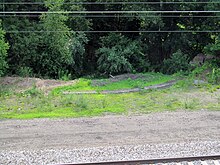
The Northeast Corridor (NEC) is an electrified railroad line in the Northeast megalopolis of the United States. Owned primarily by Amtrak, it runs from Boston in the north to Washington, D.C., in the south, with major stops in Providence, New Haven, Stamford, New York City, Newark, Trenton, Philadelphia, Wilmington, and Baltimore. The NEC is roughly paralleled by Interstate 95 for most of its length. Carrying more than 2,200 trains a day, it is the busiest passenger rail line in the United States by ridership and service frequency.

The Providence and Worcester Railroad is a Class II railroad operating 612 miles (985 km) of tracks in Rhode Island, Massachusetts, and Connecticut, as well as New York via trackage rights. The company was founded in 1844 to build a railroad between Providence, Rhode Island, and Worcester, Massachusetts, and ran its first trains in 1847. A successful railroad, the P&W subsequently expanded with a branch to East Providence, Rhode Island, and for a time leased two small Massachusetts railroads. Originally a single track, its busy mainline was double-tracked after a fatal 1853 collision in Valley Falls, Rhode Island.

The Old Colony Railroad (OC) was a major railroad system, mainly covering southeastern Massachusetts and parts of Rhode Island, which operated from 1845 to 1893. Old Colony trains ran from Boston to points such as Plymouth, Fall River, New Bedford, Newport, Providence, Fitchburg, Lowell and Cape Cod. For many years the Old Colony Railroad Company also operated steamboat and ferry lines, including those of the Fall River Line with express train service from Boston to its wharf in Fall River where passengers boarded luxury liners to New York City. The company also briefly operated a railroad line on Martha's Vineyard, as well as the freight-only Union Freight Railroad in Boston. The OC was named after the "Old Colony", the nickname for the Plymouth Colony.

The Norfolk County Railroad was a railroad in Massachusetts, United States. Chartered as two different companies in 1846 and 1847, it completed a rail line between Dedham and Blackstone in 1849. A branch to Medway, Massachusetts was built in 1852. The railroad was leased by the Boston and New York Central Railroad, succeeded by the Boston and Providence Railroad and the East Thompson Railroad, before the Norfolk County Railroad returned to independent operation in 1858. In 1866, the Boston, Hartford and Erie Railroad leased the Norfolk County. The Rhode Island and Massachusetts Railroad was completed in 1877 from Franklin southward to Valley Falls, Rhode Island, and became a branch of the Norfolk County mainline. The northernmost portion of the main line from Islington to Dedham was rerouted to the east in 1881, and the original alignment abandoned two years later. The New York, New Haven and Hartford Railroad assumed operation of the Norfolk County lines in 1898.

Providence station is a railroad station in Providence, Rhode Island, served by Amtrak and MBTA Commuter Rail. The station has four tracks and two island platforms for passenger service, with a fifth track passing through for Providence and Worcester Railroad freight trains. It is now the 11th busiest Amtrak station in the country, and the second-busiest on the MBTA Commuter Rail system outside of Boston.

The New York, Providence and Boston Railroad, normally called the Stonington Line, was a major part of the New York, New Haven and Hartford Railroad between New London, Connecticut and Providence, Rhode Island. It is now part of Amtrak's high-speed Northeast Corridor.

Wickford is a small village in the town of North Kingstown, Rhode Island, United States, which is named after Wickford in Essex, England. Wickford is located on the west side of Narragansett Bay, just about a 20-minute drive across two bridges from Newport, Rhode Island. The village is built around one of the most well-protected natural harbors on the eastern seaboard, and features one of the largest collections of 18th century dwellings to be found anywhere in the Northeast. Today the majority of the village's historic homes and buildings remain largely intact upon their original foundations.

Wickford Junction station is a commuter rail station located in North Kingstown, Rhode Island, United States. It is the southern terminus of the MBTA Commuter Rail Providence/Stoughton Line and serves as a park and ride location for commuters to Providence and Boston. The station consists of a single high-level side platform on a stub-end siding next to the Northeast Corridor mainline.

The East Junction Branch is a rail line in Rhode Island and Massachusetts, in the United States. Originally built by the Boston and Providence Railroad (B&P) in 1835, the line connects Attleboro, Massachusetts, and East Providence, Rhode Island via Seekonk, Massachusetts. As built, the line continued across the Seekonk River to Providence via the India Point Railroad Bridge; this connection was removed during the 1970s. The East Junction Branch meets the Northeast Corridor in Attleboro at a point known as East Junction, and ends at a connection to the East Providence Branch in East Providence. CSX Transportation operates freight service on the branch in Attleboro, while the Providence and Worcester Railroad (P&W) operates freight service in East Providence and across the state line into Seekonk. The line is owned by the P&W in Rhode Island, and by the Massachusetts Bay Transportation Authority in Massachusetts.
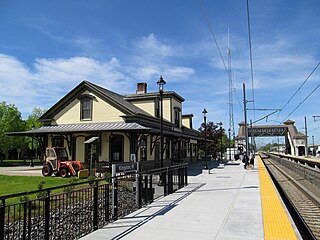
Kingston is a historic railroad station located on the Northeast Corridor in the village of West Kingston, in the town of South Kingstown, Rhode Island. It was built at this location in 1875 by the New York, Providence and Boston Railroad, replacing earlier stations dating back to the opening of the line in 1837. Current rail services consist of Northeast Regional trains in each direction, most of which stop at the station. Historically Kingston provided commuter rail service to Providence and Boston via Amtrak's commuter rail services. The MBTA is looking at extending their commuter service on the Providence/Stoughton Line.

The Fall River Line was a combination steamboat and railroad connection between New York City and Boston that operated between 1847 and 1937. It consisted of a railroad journey between Boston and Fall River, Massachusetts, where passengers would then board steamboats for the journey through Narragansett Bay and Long Island Sound to the line's own Hudson River dock in Manhattan. For many years, it was the preferred route to take for travel between the two major cities. The line was extremely popular, and its steamboats were some of the most advanced and luxurious of their day.

The Newport and Narragansett Bay Railroad is a heritage railroad that operates on Aquidneck Island, Rhode Island. It was formed in 2014-15 from the merger of the for-profit Newport Dinner Train and the nonprofit Old Colony and Newport Scenic Railway.
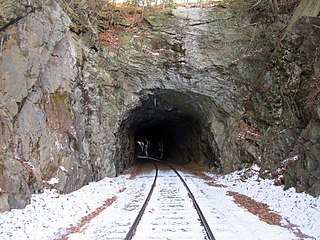
The Norwich and Worcester Railroad (N&W) was a railroad in the U.S. states of Connecticut and Massachusetts. Its north-south mainline ran between its namesake cities of Worcester, Massachusetts, and Norwich, Connecticut,. The Providence and Worcester Railroad (P&W) owns the ex-N&W line and operates freight service.

Providence was a large sidewheel steamer launched in 1866 by William H. Webb of New York for the Merchants Steamship Company. The first of Narragansett Bay's so-called "floating palaces", the luxuriously outfitted Providence and her sister ship Bristol, each of which could carry up to 1,200 passengers, were installed with the largest engines then built in the United States, and were considered to be amongst the finest American-built vessels of their era.

The Narragansett Pier Railroad was a railroad in southern Rhode Island, running 8.5 miles (13.7 km) from West Kingston to Narragansett Pier. It was built by the Hazard family of Rhode Island to connect their textile mills in Peace Dale to the New York, Providence and Boston Railroad at Kingston Station, as well as to ocean-going steamboats at Narragansett Pier. Upon opening in 1876, the railroad also proved crucial in the growth of Narragansett Pier into a major resort. Initially operated at a loss absorbed by the Hazards, by the 1890s the railroad became consistently profitable and handled a brisk passenger business along with freight and mail shipments. The Hazards also operated a connecting steamboat service to Newport.

The Providence, Warren and Bristol Railroad was a railroad in the state of Rhode Island that connected the city of Providence with Bristol, Rhode Island. The company was formed in 1854 by merging the Providence, Warren and Bristol Railroad Companies of Massachusetts and Rhode Island. The 14.1-mile line itself was completed on July 12, 1855.
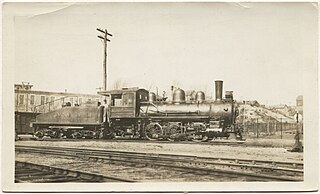
The Moshassuck Valley Railroad, founded in 1874, was a shortline railroad in Rhode Island, United States. Built from 1876 to 1877, it operated on a 2-mile (3.2 km) long line between Lincoln and a connection to the Providence and Worcester and Boston and Providence railroads, both of which were subsequently purchased by the New York, New Haven and Hartford Railroad, in the Woodlawn neighborhood of Pawtucket. The company was formed by the Sayles brothers, owners of a significant mill in Saylesville near the line's terminus. Freight was the primary traffic of the railroad, but frequent passenger service was also provided by a self-propelled steam passenger car until 1921.

The East Providence Branch is a railroad line in Rhode Island and Massachusetts, in the United States. It connects Valley Falls, Rhode Island, to East Providence, Rhode Island, via South Attleboro, Massachusetts, and Pawtucket, Rhode Island. The branch was originally built by the Providence and Worcester Railroad (P&W) in 1874, connecting its main line to a coal dock in East Providence, and was 7 miles (11 km) in length. At East Providence, the branch also met the East Junction Branch of the Boston and Providence Railroad and the mainline of the Providence, Warren and Bristol Railroad. Built as a single-track railroad with bridges and the right-of-way prepared for future double-tracking, the line was fully double-tracked from 1892 to 1895; the second track was eventually removed.
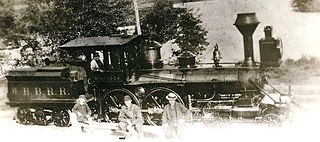
The Wood River Branch Railroad was a shortline railroad in Rhode Island, United States. Chartered in 1872 and opened on July 1, 1874, the 5.6-mile (9.0 km) line operated until 1947. It connected Hope Valley, Rhode Island, to the New York, Providence and Boston Railroad mainline at Wood River Junction. Though always nominally independent, the company was closely affiliated with the Stonington Line and its successor, the New York, New Haven and Hartford Railroad, which held significant portions of its stock.



